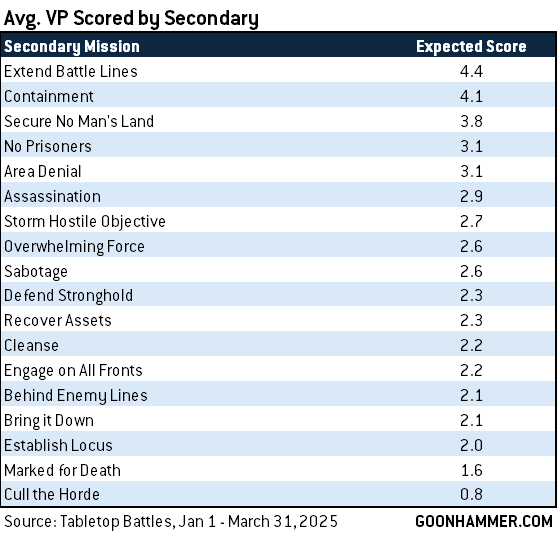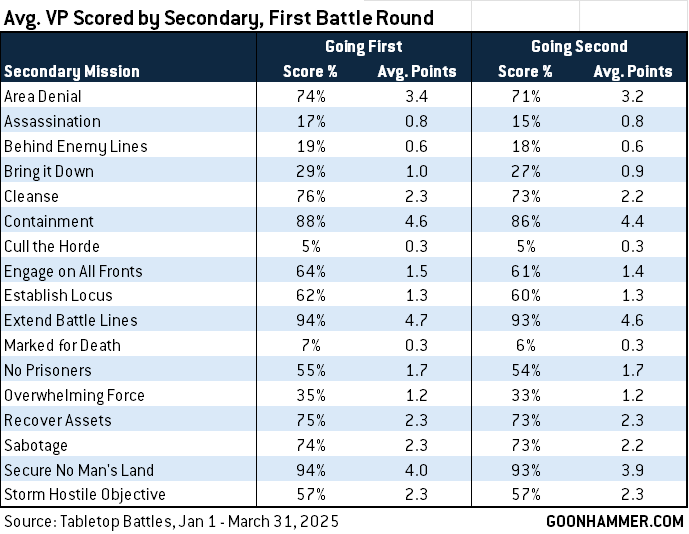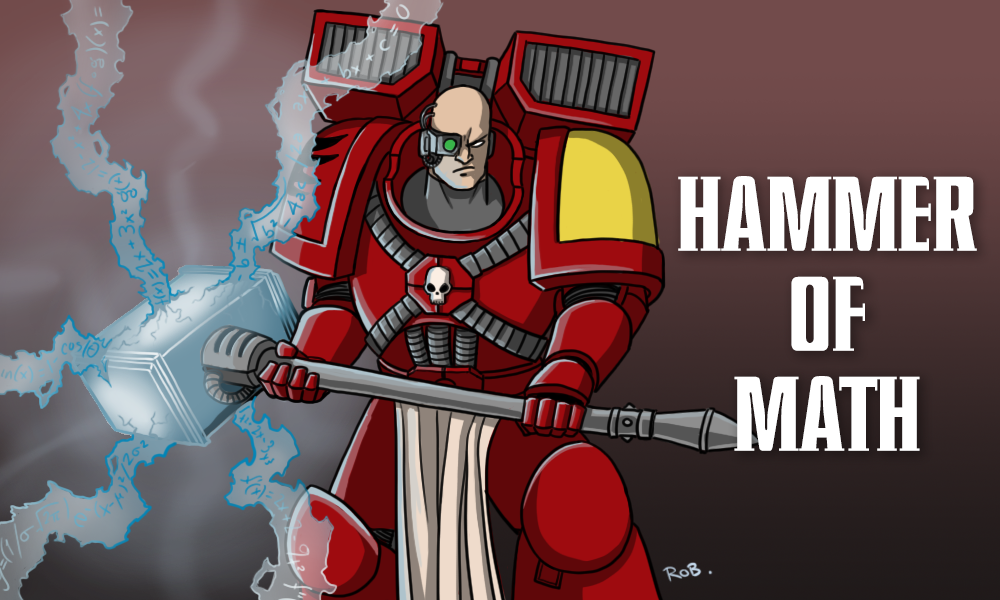In Hammer of Math, we look at key topics in Warhammer and tabletop games that involve probability, math, and statistics, looking at how these factors influence the game. This week we’re starting a multi-part miniseries on scoring in games of Warhammer 40,000.
Last time around I introduced the challenge of scoring 100 victory points in games of Warhammer 40,000, a topic that came up when we started looking at the stellar run of games Folger Pyle played at Adepticon with Ynnari. If you missed part 1 of this series, you can find it here.
That article ended with us looking at the top-scoring factions and Detachments in the game when it comes to primary and secondary VP scoring, and the factions with the highest chances of maxing out scoring. Turns out that some factions – those with high model counts and lots of speed (but more so the former than the latter) – are much better at maxing secondary scoring, while elite factions tend to be better at maxing primary, but maxing out primary is almost twice as easy as maxing out secondary, so factions which can max secondary VP have the advantage.
That said, the results Folger posted were still well above the expected average for his Detachment – Devoted of Ynnead were among the factions most likely to score max VP, but were doing so only 7.7% of the time (good for 2nd among Detachments) in our Tabletop Battles sample since January 1st. That suggests another key element to this, which is aggressive play around secondary draws and scoring. The Pariah Nexus missions pack allows players to redraw a secondary objective in the Command phase, giving players an opportunity to trade out an un-scorable objective for a new one, and players can discard any number of unscored objectives at the end of their turn. This means that players have a lot of agency in how they’ll handle draws each turn.
One way to understand how to make decisions for scoring secondary VP is to build a model for drawing and scoring secondary objectives. Once we have that, we can run a bunch of simulations using the model and then look at the results, tweaking them in various ways to test different approaches to drawing and scoring secondary objectives.
What can be Scored
If we’re going to build some models around scoring secondary VP, we need to start by understanding what can and can’t be scored – not every secondary objective is scorable on the first turn of the game (some you are forced to redraw), and some just generally can’t be scored without a huge assist from your opponent, especially if you’re going first. A great example of this is Marked for Death – Marked is one of the game’s hardest secondary objectives, and players score it less than one third of the time when they draw it.
- Defend Stronghold is the only secondary objective which cannot be held on turn 1, and must be shuffled back and redrawn.
- Behind Enemy Lines and Storm Hostile Objective can be scored on turn 1, but can also be redrawn. If you have the first turn it’s extremely unlikely you’ll score Storm Hostile, as doing so typically requires an opponent to infiltrate a unit onto an objective before the game starts.
- Bring it Down, Cull the Horde, Engage on All Fronts, and Marked for Death can all be redrawn if they don’t meet certain criteria, such as an opponent not having vehicles, or not having the necessary units.
We’ll need those rules, plus we can generally build a few more into our model – we should generally assume that going first missions like Assassination will rarely score, and others may just be secondary objectives we don’t want to attempt – while we can often score full VP for Engage on All Fronts by rushing out to every quarter of the table with our fastest units, it’s seldom a good idea to so on the first turn, especially when it would leave those units in the open and without support, basically sacrificing them for an additional VP. That’s something we’ll want to think about when building a model as well.
Finally, there’s another set of data we can use for this – Tabletop Battles gives us a great baseline to understand how often the average player scores each secondary objective, and what they achieve when they do.

This shows us some interesting things – Cull is an outlier here because it is redrawn in most instances and discarded rather than being shuffled back into the deck (reshuffled cards will not count as being drawn), but Marked for Death is pretty dire as a secondary mission potentially worth 5 VP. This is helpful data for our model as well since it can be used to determine the score an average player will get (rather than a top player) on each secondary, and as such will prove useful when it comes to building strategies for redrawing.
Turn 1 Scoring
The other thing we have to figure out is turn 1 scoring – whether we go first or second can affect how we’ll score certain secondaries. Kill secondaries can be easier going second, as opponents are likely to have moved out into the open to hold objectives or set up for a “go” turn, while positional secondaries that require holding objectives can be easier going first, ad opponents are not likely to already be on objectives turn 1.

This was a surprising result, in that we generally expected to see going second having some secondary objectives have higher scoring percentages and raw values, but instead going first tended to produce better results. Some of this makes intuitive sense – positional secondaries are more “free” when you’re going first – Area Denial is easier to score when an opponent’s only defense is having Infiltrators within 6″ of the middle of the table – but we expected kill secondary scoring to be higher for players going second. That said, this is based on our experience of “deploying to not allow turn 1 kills,” but that may not be the case in the average game. I don’t think I’ve played a tournament game where Assassination was scorable on turn 1 when I went first.
Building the Model
Looking at the data from Tabletop Battles shows us something interesting right away: Those scores don’t add up to 40 VP. Specifically, if we total the expected scores for the top ten secondary missions on there, we only end up with 31.6 VP. So our average players are much more likely to be scoring 30 than they are 40 for secondary missions.
After talking about this problem with Stat Check’s Jeremy Atkinson, he went ahead and put together a Python script for running game simulations based on going first or second, with the ability to change or incorporate certain assumptions about the data. This is the primary model we used for simulations, with some assists from “Primaris” Kevin Genson. Using the assumptions we listed above, we started with the standard running simulations – ten thousand at a time, with some interesting results.
First Attempt: Expected Value Scoring
As mentioned above, if we assume players will score the expected value of each secondary objective, then 100% of our simulations end with players falling short of 40 VP, and a median of 27. Scores here are better for players going second – our assumptions model generally advantages them with more turn 1 scoring and increases in scoring for Recover Assets and Sabotage on the final turn – but the max there was still 37 VP.
Ultimately scoring 40 VP means that you have to average 4 VP per secondary drawn, since you’ll draw ten over the course of a game. Or rather, 8 VP per round, since each turn we’ll have two secondary missions to score. If you have a bad round 1, scoring 0 VP, you’ll need to make those up, and scoring 40 VP in four rounds means averaging 10 VP per round instead of 8. This can’t really be done without big assists from the likes of Bring it Down and Containment, which allow you to score 6+.
Second Attempt: Scoring Maximum VP
On the other hand, if we assume players just score everything they draw, then they’ll reach a maximum score around 60% of the time. This varies pretty substantially based on going first or second, with players going second likely to achieve maximum VP around 83% of the time.
That’s pretty solid, and in-line with what we might expect for a good player dominating, but that still means we should expect a good player to get at most four 100-point scores in every five games, as games will often just offer multiple secondary missions which either can’t be scored for maximum points at the time or only score for 3 VP. What happens if we introduce discarding to the mix?
Third Attempt: Aggressively Discarding
In this final model, we aggressively discard secondaries if they aren’t worth enough VP. We’ll look at how we might benefit from discarding when our pair are worth fewer than 3 VP (i.e. one is un-scorable and the other is bad), fewer than 7 VP, and fewer than 8 VP. Remember that these models assume a player will score most or all of the VP available for each secondary, with some adjustments based on the round and whether they are going first or second.
- Some Discarding – In the model where we discard only when our secondaries are worth a combined 2 VP or less, the player going first hits max score only 54% of the time, while the player going second makes it 72% of the time.
- Discarding Below 7 – In this model, the player going first hits 40 points about 63% of the time, while the player going second hits it 83% of the time.
- Discarding Below 8 – In our most aggressive model, the player going first hits 40 VP 73% of the time, compared to 90% for the player going second.
That’s a huge jump, and essentially gives us the final piece of the puzzle here – if you want to maximize your chances of scoring 100 VP in games, you’ve got to make sure your draws give you a statistical chance of getting there, and that means spending CP to discard whenever your secondaries put you behind pace.
Final Thoughts
This was one of the more interesting challenges we’ve had to tackle here in some time. It started with an interesting question and had some cool – and applicable results. As a player I’m still not sure if I can afford to aggressively discard secondary missions and still win my games – I use that extra CP often – but that’s also because I’m usually playing Chaos marine armies which are not great at scoring secondary objectives. It’s clear that when you combine these two factors – being good at scoring/maxing secondary objectives with an aggressive discard strategy, you can generate some very impressive results.
Have any questions or feedback? Drop us a note in the comments below or email us at contact@goonhammer.com. Want articles like this linked in your inbox every Monday morning? Sign up for our newsletter. And don’t forget that you can support us on Patreon for backer rewards like early video content, Administratum access, an ad-free experience on our website and more.











![[40k] Competitive Innovations in 10th: Warping Time pt.2](https://d1w82usnq70pt2.cloudfront.net/wp-content/uploads/2020/01/Analysis_Banner.png)




